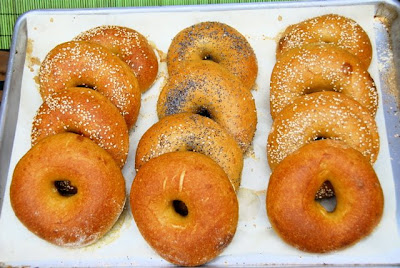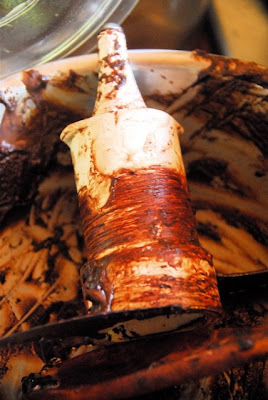
The talented Ilva of Lucullian Delights chose the recipe this month and I loved it!
The recipe comes from the book Pane: Il Piacere di Preparare il Pane in Casa by Anna Gennari. Ilva chose to make pane di pasta tenera condita which she re-named Italian Knot Bread, which in Italian means flavored soft dough bread.

I adapted Ilva's notes and used Lien's ingredient list, since they were already written with instant yeast, which I used, and she halved the recipe.
Pane di Pasta Tenera Condita
Biga
200 g normal bread flour
5 g fresh yeast or 1/4 tsp dry instant yeast
170 ml water
- Dissolve the yeast in a little water and quickly work the dough together.
- Put it in a container, cover it with a half closed lid or kitchen towel and leave it for 15-24 hrs.
Dough
250 g biga
500 g flour (type 00)
200-260 ml water, lukewarm
15 g fresh yeast or 1 1/2 tsp dry instant yeast
25 g extra-virgin olive oil
30 g lard (or butter)
12 g honey
12 g salt
- Put the flour either in a big bowl or on a baking board, add the lard and mix it with your fingers until it has 'crumbled' and is completely mixed with the flour.
- Dissolve the yeast in little tepid water and add it to the flour. Mix as well as you can.
- Mix salt, olive oil and honey with the like-warm water and add it to the flour. Mix the dough until it holds together and then add the biga.
- Work the dough until it is smooth and doesn't stick either by hand or with a mixer.
- Put it into a bowl, cover it and leave to rise until it has doubled.
- After the dough has doubled, divide it into smaller parts, about 100 g/3,5 oz each.
To see how to shape each piece of dough please check Ilva's or Lien's websites.
1. Roll out each portion into 20" long stands and lay them out on a flat surface.
2. Make a semi-circle with the dough stand.
3. Twist the two end together.
4. Bring the two ends towards the upper part of the circle.
5. Lift/fold the top part over the twisted part.
6. Take the two end and join them together under the actual knot, this will make the knot part come out more and it hides the ends.
- Put the knots on baking sheets and let to rise until they have doubled in size.
- Bake in a pre-heated oven (200°C/390°F) for 30-35 minutes.
My notes:
I absolutely loved this bread! It reminds me of the little panini I used to eat in Italy, which are always present at each child's birthday party, stuffed with butter and prosciutto. I will make it again in smaller size and keep it in the freezer for quick snacks.
The biga fermented for 15 hours only.
I decided to be lazy, and used all purpose flour for the bread. I also used butter instead of lard (both for a yuck factor, and because I have no idea where to find it). The a/p flour gave it a tender crust, and I believe that the OO flour will make this bread even more tender.
The strands were difficult to roll more than 16 inches, but I was able to form the knots as well. The shaped bread didn't look smooth at first, but once properly proofed it looked beautiful.
Baking was straightforward, the bread colored nicely.
The taste was wonderful, the crust soft, and tasty from the honey, the butter and the oil.

The bread passed the butter and jam test so it is a keeper indeed.
Thanks to Ilva and the other BBBabes! To see some of their creations check out their sites: Bake My Day (Karen), I Like to Cook (Sara), Living on Bread and Water (Monique), My Kitchen in Half Cups (Tanna), Grain Doe (Gorel), Notitie van Lien (Lien), The Sour Dough (Mary aka Breadchick), Cookie Baker Lynn (Lynn), Living In The Kitchen With Puppies (Natashya)






















